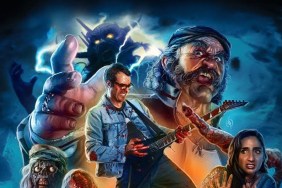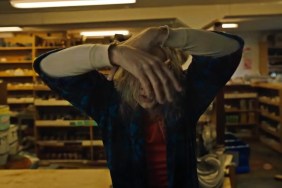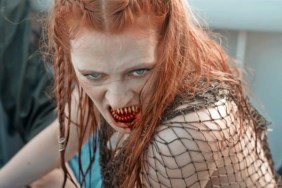
Welcome to Target Practice, where we here at Shock take a look at the output of Arrow Films. Arrow has brought the best in horror, cult and exploitation repertory titles into UK homes since 1991. Now theyve finally crossed the Atlantic, delivering genre stalwarts and oft-overlooked gems via beautiful Blu-ray & DVD editions.
Inaugurating this new column is a pair of Japanese yakuza pictures featuring era-specific icons: Massacre Gun (1967) and Blind Womans Curse (1970)

The Films
Like American Film Noir, Japanese Nikkatsu Noir has a double meaning.
Founded in 1912, the nation’s oldest studio, The Nikkatsu Corporation, has steadfastly associated itself with the sensational; rebel without a cause thrillers, yakuza shoot em ups, and oddball, transgressive erotica (sometimes of the notorious pink nature). While “noir” is nowadays often misused to indicate genre instead of era (if specificity is your game, the label primarily applies to 40s American WWII & post-WWII crime dramas such as The Maltese Falcon), it can also be recycled in order to pinpoint a certain set of aesthetics and storytelling elements. Stark black and white photography, cigarette smoke, weathered criminals, smoldering femme fatales and a fatalistic air of dread often pervade classic period examples. From the 1950s until the early 1970s, Nikkatsu experienced something of a Golden Age, churning out numerous action titles meant to appeal to the youth market. The best of these films often co-opted the look and feel of Hollywoods distinguished malaise-riddled mysteries, adding bullet-fest flair to the proceedings. However, by appropriating these filmic aesthetics, Nikkatsu Noir pictures actually feel closer in spirit to Italian spaghetti westerns an ultraviolent, madcap reflection of their tamer overseas cousins.

Every era and genre has its stars, and J? Shishido was undoubtedly one of the wildest Nikkatsu produced. Signing as a contract player with the studio in 1954, Shishido became upset with the critical reactions to his work (where he was called ruggedly handsome) and decided to have his cheeks surgically augmented, lifting them up and causing the bones in his face to become pronounced. Immediately after, Shishidos career skyrocketed, as the actor was often cast as a nefarious heavy or macho hitman. When action star Keiichiro Akagi died in a go-karting accident in 1961, Nikkatsu was in desperate need of a new marquee idol. Shishido was tapped and, until roughly 1971, became the face of Nikkatsu Action and Noir, starring in several films from maverick auteur Seijun Suzuki (Youth of the Beast, Branded to Kill). Shishido left Nikkatsu just as the studio began to fail (and shifted to making romantic pornography films in order to remain afloat), but continued to work in both television and film until the late 1990s (including Kinji Fukasakus 1974 classic Battles Without Honor and Humanity: Final Episode).
One of Shishidos best works, Massacre Gun, is a jazzy yet relatively straightforward affair. After hit man Kuroda (Shishido) is ordered to kill the woman he loves by a local mafia boss (Takashi Kanda), his boxer brother (Jirô Okazaki) rebels, only to have his hands mangled as punishment. In turn, Kuroda goes rogue, declaring a turf war on the crime mogul and his goons. Its a no frills gangland action picture, stripped down to the genres core themes of honor, redemption and a whole lot of fatalist gunplay. Directed by Yasuharu Hasebe (who began his career as an assistant to Suzuki), the entire picture has a claustrophobic feel, as if this story is closed off from any semblance of realistic Japanese life. The world of Massacre Gun is one of contained, austere apartments, sweat-soaked boxing gyms, bright bowling alleys and smoky saxophone bars, all of which are populated by black suits who tote pistols. Hasebe retains the monochromatic feel of Nikkatsu Noir forefathers like Takashi Nomura (A Colt is My Passport), but combines the stark palette with a penchant for ultra violence. Massacre Gun is a film that never, for one moment, takes the foot off the gas, as Kuroda and his brothers bulldoze through the local mob on a path to glorious vengeance.

Shishido is at his stoic best here, smoking, brooding, shooting and staring into the distance while his adversaries fall to the floor. As far as antiheroes go, his lovelorn hitman is one of the best in the genre, because we feel for the bad man despite the fact were given no real good reason to. Revenge is a torturous business on ones soul, and Shishido sells the plagued conscious Kuroda possesses. Hasebe expertly places the performer inside of the frame, preferring a demonstrative style of performance to bombastic emoting. Its a smoldering turn that practically blisters the screen.
Massacre Gun is a tableau-centric picture, the camera drifting across scenarios to focus on pieces of art or furniture as killers discuss future retribution. Hasebes style borders on the impressionistic, eschewing the formalism of the Old Hollywood pictures clearly being emulated in favor of a fragmented, jittery whole. A bar conversation captured entirely in countertop reflection becomes a knockout, while a romantic speedboat jaunt still cant escape the grey clouds of forcefulness that hang over these criminals lives. Meanwhile, a climactic shootout atop a bridge hints at a world without borders, Hasebes camera seeing well beyond these bloodthirsty maniacs. Shishido and his ilk may be portraying men whose sole focus is bringing death to their counterparts, but Suzukis old aid finds the beauty in a boundless arena of excessive, masculine lunacy.

Where Massacre Gun and its Nikkatsu Noir brethren are indebted to another countrys bygone epoch, Teruo Ishiis Blind Womans Curse owes almost its entire existence to an industry that spent a good amount of its time churning out samurai pictures. Instead of sticking with the rigid structuralism masters like Kurosawa favored, Ishii dabbles in full-blown psychedelic. Ishii engulfs the viewer from the get go during a slow motion, freeze-framed sword fight (over which blood red titles are laid). Blind Womans Curse operates in a completely heightened netherworld, where cats drink from the gouged eyes of children and men move in synchronicity, as to keep their connective dragon back tattoo unified. Its a ballsy, evocative start to a stirring film, yet shouldnt come as a surprise to those familiar with Ishiis background in Japanese horror.
Ishii was fascinated with the work of horror author Edogawo Rampo, whose stories came with their own moniker (erotic-grotesque). When combined with the filmmakers examination of Japans history of mercilessness (he directed eight films in the Shoguns Joys of Torture series), it becomes clear that Ishii was an unparalleled master at combining the carnal with the cruel. Yet Ishiis addiction to vibrant, eye-popping colors creates visual discord, lending Blind Womans Curse an air of reverie. Even the bluntest of sword violence carries a slightly inappropriate elegance that shifts the audience off balance. But like Massacre Gun, the movie cant help but slip into traditional cinematic language, as its characters are often placed against panoramic backdrops, dwarfed by the Japanese sky above.
Meiko Kaji is one of the most furiously beautiful women who ever existed. As the titular leader of the Tachibana clan, Kaji channels the same ethereal poise she exhibited in Toshiya Fujitas Lady Snowblood films. However, instead of acting as an instrument of revenge against those who did her mother wrong, Akemi Tachibana becomes a somewhat supernatural force of sheer will and violent determination, holding command over a gang thats keen to do her bidding. The war she wages allows Ishii to indulge his love of neon gore and smashed teeth. Together, the director and his star create a stagey, pseudo-feminist ode to samurai cinema that is working on a visual plane all its own. When double-featured with Massacre Gun, you get a snapshot of both sides of the Japanese genre spectrum in the late 60s/early 70s. Nikkatsu was a studio that never saw sense in conformity, resulting in some of the most striking pop art in the mediums history.

The Discs
Whats incredibly cool about Arrows dual format releases is that, like Criterion, theyre all about placing the titles they choose within a particular context. Japanese cinema expert Jasper Sharp provides a commentary track to Blind Womans Curse and an essay on Massacre Gun, outlining how the pictures fit into the history of their studio. Film historian Tony Rayan assists with his ten part (!) interview for Massacre Gun, discussing the social climate in Japan before and after WWII, as well Nikkatsu’s history and the influence of American films on Japanese cinema.
Tom Mes does the honors for the liner notes on Blind Womans Curse, focusing on the film in terms of what the author describes as literary nonsense. All are wonderful, challenging supplemental materials, demanding that the viewer intellectually engage with not only the films, but also several facets of Japanese culture that both prejudiced and, in turn, were influenced by these particular pieces of cinema. A new interview with Shishido is another highlight, as the actor details not only his early, personal life, but also discusses his lengthy career (rather frankly at times). The requisite original theatrical trailers for both films are included on their respective discs, but Blind Womans Curse also contains four promos for Meijo Kajis Stray Cat Rock series. All in all, even if the viewer knows nothing about Nikkatsu studios before sitting down with either of these films, they can walk away feeling edified on a new subsection of cult cinema.
As for the high def transfers, Nikkatsu prepared both for Arrow and they look fairly stunning. Blind Womans Curse has the upper hand through aesthetics alone, as the striking colors jump off the screen. Theres some minor print wear, dirt and damage apparent, but nothing distracting or digitally added. Massacre Gun looks quite good as well, but there are a few instances early on (namely during the piano bar scenes) where the blacks couldve been slightly sharper and the edges crisper. Still, these are small potato gripes when this is the first time the movie has been available on Blu anywhere in the world. Additionally, the uncompressed mono PCM audio is incredibly clean, with zero pops, hissing or drops. Without a doubt, these are must buys for anyone who remotely fancies him or herself a fan of Japanese cinema.

—
Jacob Knight is an Austin, Texas based film writer who moonlights as a clerk at Vulcan Video, one of the last great independent video stores in the US. You can find find him on Twitter @JacobQKnight.









